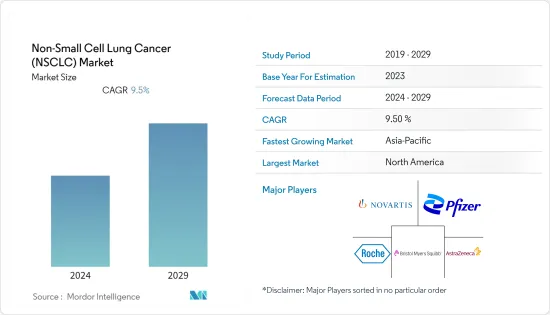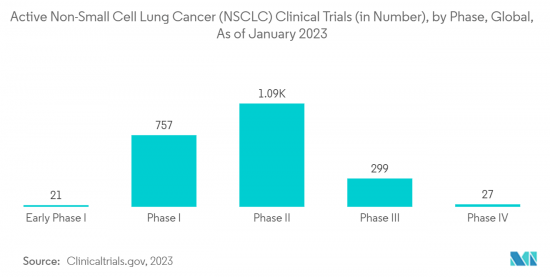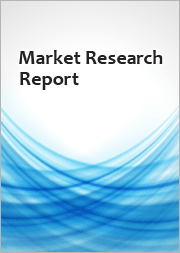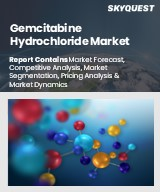
|
시장보고서
상품코드
1406998
세계 비소세포폐암(NSCLC) 시장 - 점유율 분석, 산업 동향, 통계 및 성장 예측(2024-2029년)Non-Small Cell Lung Cancer (NSCLC) - Market Share Analysis, Industry Trends & Statistics, Growth Forecasts 2024 - 2029 |
||||||
비소세포폐암(NSCLC) 시장은 예측 기간 동안 CAGR 9.5%를 나타낼 것으로 예상됩니다.

COVID-19는 비소세포 폐암 시장의 성장에 크게 영향을 미치고 있습니다. 예를 들어, clinicaltrials.gov에 따르면 2021년 7월 현재 200개 이상의 개입 연구가 유행 중에 중단되었습니다. 이 때문에 유행 기간 동안 시장 성장은 둔화되었습니다. 그러나 규제가 해제되고 서비스가 재개됨에 따라 이 회사는 비소세포 폐암 치료를 위한 임상시험의 실시에 주력하게 되었습니다. 예를 들어, 2022년 10월, Daiichi Sankyo, Inc.는 AstraZeneca와 협력하여 HER2 돌연변이 전이성 비소세포 폐암(NSCLC)에 대한 트라스투주맙 델크스테칸의 안전성 및 효능을 평가하는 2상 임상시험을 실시합니다. 이러한 활동을 통해 연구 대상 시장은 예측 기간 동안 성장할 것으로 예상됩니다.
비소세포 폐암을 앓고 있는 환자 수 증가와 흡연, 담배와 알코올의 섭취, 보충제의 대량 섭취, 앉지 않은 생활 등 건강에 해로운 습관을 가진 사람들 증가가 세계 시장의 성장을 견인 하고 있습니다. 예를 들어, 2022년 12월에 발표된 뉴스에 따르면 전 세계적으로 약 220만명의 신규 사례가 전흉부 종양 증례의 11.4%에 포함되어 있으며, 이 수는 2025년까지 두배로 될 것으로 예측되고 있습니다. 또한, 국립암 등록계획(ICMR-NCRP)이 2022년 12월에 발표한 데이터에 의하면, 폐암 증례 수는 2020년의 98,278건에서 2022년에는 103,371건이 되어, 5% 증가했습니다. 이처럼 인구 사이에서 폐암 부담이 크므로 효과적인 치료 옵션에 대한 수요가 높아지고 있으며, 이는 시장 성장을 가속할 것으로 예상됩니다.
또한 NSCLC의 치료에 효과적인 약물의 연구 개발에 주력하는 기업 증가, 제품 승인 증가, 다양한 치료법의 지정이 시장 성장에 기여하고 있습니다. 예를 들어, 2022년 10월, GSK plc는 전이성 비편평 상피 비소세포 폐암 환자를 대상으로 한 Jemperli(dostarlimab)+화학요법의 2상 시험인 PERLA의 양호한 결과를 보고했습니다. 또한, 유럽 위원회는 2022년 6월 노바르티스의 타블렉터(일반명: 카푸마티닙)를 면역요법 및/또는 백금 제제 기반 화학요법으로 치료하기 전에 전신요법을 필요로 하는 진행 비소세포폐암(NSCLC)) 성인 환자에 대한 단일 요법으로 승인했습니다. 마찬가지로 2022년 2월 의약품·헬스케어 제품 규제청(MHRA)은 Genentech의 테센트릭을 조기 비소세포 폐암 치료제로 승인했습니다.
게다가 폐암 환자를 치료하기 위한 효과적인 치료법을 개발하기 위한 기업에 의한 투자 증가도 시장 성장을 가속할 것으로 예상됩니다. 예를 들어, 임상 단계 의약품 개발 기업인 DeuterOncology는 2023년 1월에 565만 유로(610만 달러)의 시리즈 A 자금 조달 라운드를 완료했습니다. 이 자금 조달에 의해 회사는 주력 제품인 개량형 MET 키나아제 억제제 DO-2의 I상 임상시험을 개시할 수 있어 폐암에 대한 동급 최고의 표적 치료제가 될 가능성으로 개발 진행되고 있습니다. MET 억제제는 최근 MET 엑손 14 건너뛴 돌연변이를 가진 비소세포 폐암(NSCLC) 환자에 대해 승인되었습니다.
따라서 비소세포폐암의 높은 부담, 연구개발 활동의 활성화, 제품 승인 등의 요인에 의해 연구시장은 예측기간 중에 성장할 것으로 예상됩니다. 그러나, 치료나 약제의 비용이 높고, 신흥 국가에서의 진단율이 낮은 것이, 예측 기간중의 비소세포폐암의 성장을 저해할 가능성이 높습니다.
비소세포 폐암(NSCLC) 시장 동향
표적 약물 요법 부문이 예측 기간 동안 큰 시장 점유율을 차지할 전망
비소세포 폐암의 이환율 상승이나 신규 치료법 시장 개척을 위한 기업 활동의 활성화 등의 요인에 의해 표적 치료제 부문은 예측 기간 중에 시장에서 큰 성장을 이룰 것으로 예측됩니다.
표적 치료제는 진행된 폐암의 치료에 사용되는 경우가 많아 화학요법과 병용되거나 단독으로 사용됩니다. 비소세포 폐암을 치료하는 주요 표적 치료제로는 에를로티닙(탈세바), 게피티닙(이레사), 아파티닙(길로트리프), 모보세르티닙(익스키티비티), 오시멜티닙(태그리소), 다코미티닙(비짐프로) 등이 있습니다. 이 약물은 신체의 돌연변이 유전자를 표적으로함으로써 건강한 세포에 악영향을 미치지 않습니다. 표준 화학요법에 대한 우위로 시장 각사가 표적 치료제의 개발에 투자하고 있으며, 이러한 약제가 세계 각국에서 발매되고 있는 것이 시장 성장의 촉진력이 되고 있습니다. 예를 들어, 2021년 10월, AUM Biosciences는 시리즈 A 자금 조달 라운드에서 2,700만 달러를 조달했습니다. 이러한 기금은 회사의 정밀암 치료 및 표적암 치료의 임상 단계 파이프라인을 전진시키는 데 사용됩니다.
MDPI가 2022년 12월에 발표한 기사에 의하면, 정밀의료의 출현은 비소세포폐암의 치료에 빛을 맞추고, 유전적·후성적 마커를 표적으로 한 치료에 의해 진행 NSCLC 환자가 이용할 수 있는 옵션을 증가했습니다. 또한 2021년 6월 Journal of Hematology and Oncology에 게재된 논문에 따르면 표적 치료를 받은 환자는 화학요법을 받은 환자에 비해 무증악 생존 기간이 유의하게 개선된 것으로 관찰 되었습니다. 또한 이 출처에 따르면 표적 치료를 받은 환자에서 EGFR, ALK, ROS1, BRAF 유전자 변이를 가진 환자의 주효율은 50%에서 80%였습니다. 따라서, 분자 표적 치료제의 효능은 NSCLC 환자의 치료에 대한 수요와 마찬가지로 채택을 증가시키고, 따라서 이 부문의 성장을 가속합니다.
게다가, 표적 치료제의 승인이 증가함에 따라 시장에서 새로운 치료제의 가용성이 높아지고 예측 기간 동안 같은 분야의 성장을 가속할 것으로 예상됩니다. 예를 들어, 2022년 8월, AstraZeneca와 Daiichi Sankyo의 표적 치료제 Enhertu는 종양에서 활성화된 HER2(ERBB2) 돌연변이를 갖는 절제 불가능 또는 전이성 비소세포 폐암 성인 환자의 치료제로 미국에서 승인되었습니다. 했습니다. 또한 2021년 5월 미국 FDA는 상피성장인자수용체(EGFR) 엑손 20 삽입변이 등 특정 유전자 변이를 가진 성인 비소세포 폐암 환자에 대한 최초의 표적 치료제로서 라이브 레반트(amivantamab-vmjw))를 승인했습니다.
따라서 기업과 연구기관에 의한 연구활동의 활성화, 표적 약물치료치료의 채용 확대, 제품승인 증가 등의 요인에 의해 조사대상 부문은 예측기간 중에 성장할 것으로 예상됩니다.

북미가 예측 기간 동안 큰 시장 점유율을 차지할 전망
북미는 인구간에 비소세포 폐암 환자수가 증가하고 있는 것, 동지역의 주요 기업이 상시와 당국으로부터의 승인 취득에 주력하고 있는 등의 요인으로부터, 예측 기간 중에 시장이 크게 성장할 것으로 예상됩니다. 또한 각 회사의 R&D 투자 증가와 이 지역의 엄청난 건강 관리 지출도 시장 성장에 기여하고 있습니다.
인구 사이에서 NSCLC의 부담이 증가하고 있다는 것이 이 지역 시장 성장을 가속하는 주요 요인입니다. 예를 들어, ACS가 발표한 2023년 통계에 따르면 미국에서는 2023년에 약 23만 8,340명의 폐암 환자가 새롭게 진단될 것으로 예상되고 있습니다. 또한 캐나다암협회가 발표한 2022년 통계에 따르면 캐나다에서는 약 30,000명의 캐나다인이 폐암 및 기관지암으로 진단되어 2022년 신규암 사례의 13%를 차지했습니다. 이와 같이 폐암을 앓고 있는 사람의 많음은 화학요법, 표적요법 등과 같은 효과적인 치료요법에 대한 수요를 부추기고 있습니다. 이것은 예측 기간 동안 시장 성장을 가속할 것으로 예상됩니다.
게다가 캐나다 통계국이 발표한 데이터에 의하면, 2022년 1월, 폐암은 캐나다에서 가장 빈번하게 진단되는 암이며, 암 관련 사망의 주된 원인이 되고 있습니다. 폐암 환자의 약 50%는 생존 가능성이 믿을 수 없을 정도로 낮은 4단계에서 발견됩니다(5년 동안 4%). 이처럼 주로 최종 스테이지에서 발견되는 폐암의 부담이 크기 때문에 효과적인 약제와 함께 화학요법 세션 수요가 높아지고 예측 기간 중 시장 성장을 뒷받침할 것으로 기대되고 있습니다.
게다가 기업활동의 활성화와 제품인증 증가도 예측기간 동안 시장성장을 높일 것으로 예상됩니다. 예를 들어 캐나다 보건부는 2022년 8월 절제 가능한 비소세포폐암(NSCLC) 성인 환자를 대상으로 한 네오애쥬번트 요법에 있어서, Bristol Myers Squibb의 옵디보 360mg(정주용 주사제)를 플래티넘 제제로의 병용으로 3주마다 3사이클 투여하는 것을 승인했습니다. 또한, 2022년 1월, 미국 FDA는 AbbVie의 임상시험약인 테리소투주맙 베도틴(Teliso-V)을 백금 제제에 의한 치료 중 또는 치료 후에 병세가 진행된 c-Met 과발현이 고치의 상피 성장 인자 수용체(EGFR) 야생형의 진행성/전이성 비편평상피 비소세포폐암(NSCLC) 환자의 치료제로서 획기적 치료제 지정(Breakthrough Therapy Designation: BTD)을 승인했습니다.
따라서 제품 승인이나 제품출시 증가, 비소세포 폐암 증례 수 증가 등 앞서 언급한 요인에 따라 조사 대상 시장은 예측 기간 동안 성장할 것으로 예상됩니다.
비소세포 폐암(NSCLC) 산업 개요
비소세포 폐암 시장은 세분화된 경쟁 시장으로 여러 대형 기업으로 구성되어 있습니다. 각 회사는 시장에서의 지위를 유지하기 위해 제휴, 파트너십, 신제품 출시, 기타 노력 등 다양한 주요 사업 전략을 채택하고 있습니다. 이 시장의 주요 기업으로는 F. Hoffmann-La Roche, AstraZeneca, Bristol-Myers Squibb, Merck, Novartis, Pfizer, Takeda Pharmaceuticals, Bayer Healthcare, Eli Lilly and Company, GlaxoSmithKline 등이 있습니다.
기타 혜택:
- 엑셀 형식 시장 예측(ME) 시트
- 3개월간의 애널리스트 서포트
목차
제1장 서론
- 조사의 전제조건과 시장 정의
- 조사 범위
제2장 조사 방법
제3장 주요 요약
제4장 시장 역학
- 시장 개요
- 시장 성장 촉진요인
- 신규 치료 개발에 대한 투자 증가
- NSCLC의 유병률 증가
- 시장 성장 억제요인
- 신흥 국가에서의 치료 및 약제의 높은 비용과 낮은 진단률
- Porter's Five Forces 분석
- 신규 참가업체의 위협
- 구매자/소비자의 협상력
- 공급기업의 협상력
- 대체품의 위협
- 경쟁 기업간 경쟁 관계의 강도
제5장 시장 세분화
- 암 유형별
- 편평상피암
- 선암
- 대세포암
- 치료법별
- 화학요법
- 표적요법
- 면역요법
- 기타 치료법
- 지역별
- 북미
- 미국
- 캐나다
- 멕시코
- 유럽
- 독일
- 영국
- 프랑스
- 이탈리아
- 스페인
- 기타 유럽
- 아시아태평양
- 중국
- 일본
- 인도
- 호주
- 한국
- 기타 아시아태평양
- 중동 및 아프리카
- GCC
- 남아프리카
- 기타 중동 및 아프리카
- 남미
- 브라질
- 아르헨티나
- 기타 남미
- 북미
제6장 경쟁 구도
- 기업 프로파일
- F. Hoffmann-La Roche Ltd.
- AstraZeneca
- Bristol-Myers Squibb Company
- Merck & Co., Inc.
- Novartis AG
- Pfizer Inc.
- Takeda Pharmaceutical Company Limited
- Bayer AG
- Eli Lilly and Company
- GlaxoSmithKline plc.
- Sanofi
- Agennix AG
제7장 시장 기회와 앞으로의 동향
JHS 24.01.31
The non-small cell lung cancer (NSCLC) market is expected to register a CAGR of 9.5% during the forecast period.
COVID-19 has significantly affected the growth of the non-small cell lung cancer market. For instance, as per clinicaltrials.gov, as of July 2021, more than 200 interventional studies were halted during the pandemic. This has slowed down the market growth during the pandemic. However, with the released restrictions and resumed services, the company has increased its focus on conducting clinical trials for the treatment of non-small cell lung cancer. For instance, in October 2022, Daiichi Sankyo, Inc. in partnership with AstraZeneca is conducting a Phase II clinical trial to evaluate the safety and efficacy of trastuzumab deruxtecan in HER2-mutated metastatic non-small cell lung cancer (NSCLC). Thus, with such activities, the studied market is expected to grow over the forecast period.
The growing number of patients suffering from non-small cell lung cancer and the increasing number of people with unhealthy habits such as smoking, tobacco and alcohol consumption, high dose of supplements, and sedentary lifestyle across the world are driving the market growth. For instance, according to the news published in December 2022, globally about 2.20 million new cases are among 11.4% of total thoracic tumor cases and this number is projected to double by 2025. Also, as per the data published by National Cancer Registry Programme (ICMR-NCRP), in December 2022, the number of lung cancer cases increased from 98,278 in 2020 to 1,03,371 in 2022, representing an increase of 5%. Thus, the high burden of lung cancer among the population has increased the demand for effective treatment options, which in turn is anticipated to fuel market growth.
Furthermore, the increasing company's focus on conducting R&D of effective drugs for the treatment of NSCLC and the increasing product approvals and various therapy designations are contributing to the market growth. For instance, in October 2022, GSK plc reported positive results from PERLA, the phase II trial of Jemperli (dostarlimab) plus chemotherapy in patients with metastatic non-squamous non-small cell lung cancer. Also, in June 2022, the European Commission approved Novartis's Tabrecta (capmatinib) as a monotherapy for the treatment of adults with advanced non-small cell lung cancer (NSCLC) who require systemic therapy following before treatment with immunotherapy and/or platinum-based chemotherapy. Similarly, in February 2022, the Medicines and Healthcare Products Regulatory Agency (MHRA) approved Genentech's Tecentriq to treat early-stage non-small cell lung cancer.
Moreover, the increasing investment by companies in developing effective therapies for treating patients with lung cancer is also expected to fuel market growth. For instance, in January 2023, DeuterOncology, a clinical-stage drug development company, closed EUR 5.65 million (USD 6.1 million) Series A financing round. This funding enables the company to initiate the phase I clinical study for its lead product DO-2, an improved MET kinase inhibitor that is being developed as a potential best-in-class targeted therapy for lung cancer. MET inhibitors have recently been approved for patients with Non-Small Cell Lung Cancer (NSCLC) harbouring the MET exon 14 skipping mutant.
Therefore, owing to the factors such as the high burden of non-small cell lung cancer, growing R&D activities, and product approvals, the studied market is anticipated to grow over the forecast period. However, the high cost of therapy or drugs and low diagnosis rate in developing countries is likely to impede the growth of non-small cell lung cancer over the forecast period.
Non-Small Cell Lung Cancer (NSCLC) Market Trends
Targeted Therapy Segment is Expected to Hold Significant Market Share Over the Forecast Period
The targeted drug therapy segment is anticipated to witness significant growth in the market over the forecast period owing to the factors such as the rising incidence of non-small cell lung cancer, and increasing company activities for developing novel treatments.
Targeted therapy drugs are often used to treat advanced lung cancers and are either used along with chemotherapy or used individually. Some of the major targeted therapy drugs to treat non-small cell lung cancer are Erlotinib (Tarceva), Gefitinib (Iressa), Afatinib (Gilotrif), Mobocertinib (Exkivity), Osimertinib (Tagrisso), and Dacomitinib (Vizimpro). These drugs targets mutated genes in the body and thereby avoid adverse effect on healthy cells. Investment by market players in the development of targeted therapy due to its advantages over standard chemotherapy and entry of these drugs in multiple countries across the world are likely to drive market growth. For instance, in October 2021, AUM Biosciences completed USD 27 million in a Series A funding round. These funds are used to advance the company's clinical-stage pipeline of precision and targeted cancer therapies.
According to an article published by MDPI, in December 2022, precision medicine's emergence has shed light on the treatment of non-small cell lung cancer, increasing the options available to patients with advanced NSCLC by targeting therapy on genetic and epigenetic markers. Additionally, as per an article published in the Journal of Hematology and Oncology, in June 2021, it has been observed that patients receiving targeted therapy showed a significant improvement in progression-free survival as compared to patients receiving chemotherapy. Also, as per the same source, for patients who underwent targeted therapy and had EGFR, ALK, ROS1, and BRAF mutations, the response rate ranged from 50% to 80%. Thus, the effectiveness of targeted drug therapy increases their adoption as well as demand for treating patients with NSCLC, hence propelling the segment growth.
Furthermore, the rising targeted therapy product approvals increase the availability of novel therapeutic drugs in the market which is also anticipated to augment the segment growth over the forecast period. For instance, in August 2022, AstraZeneca and Daiichi Sankyo's Enhertu, a targeted therapy, was approved in the United States for the treatment of adult patients with unresectable or metastatic non-small cell lung cancer whose tumors have activating HER2 (ERBB2) mutations. Also, in May 2021, the US FDA approved Rybrevant (amivantamab-vmjw) as the first targeted therapy treatment for adult patients with non-small cell lung cancer whose tumors have specific types of genetic mutations such as epidermal growth factor receptor (EGFR) exon 20 insertion mutations.
Therefore, owing to the factors such as the rising research activities by companies and institutions, growing adoption of targeted drug therapy treatment, and increasing product approvals, the studied segment is anticipated to grow over the forecast period.

North America is Expected to Have the Significant Market Share Over the Forecast Period
North America is expected to witness significant growth in the market over the forecast period owing to the factors such as the rising number of non-small cell lung cancer among the population and the presence of key players in the region focusing on launching and gaining approvals from the authorities. In addition, the increasing R&D investment by the players and huge healthcare spending in the region is also contributing to the market growth.
The increasing burden of NSCLC among the population is the key factor driving the market growth in the region. For instance, according to the 2023 statistics published by ACS, about 238,340 new cases of lung cancer are expected to be diagnosed in the United States in 2023. Additionally, as per 2022 statistics published by the Canadian Cancer Society, approximately 30,000 Canadians were diagnosed with lung and bronchus cancer, accounted for 13% of all new cancer cases, in Canada, in 2022. Thus, the high number of people suffering from lung cancer fuels the demand for effective treatment therapies such as chemotherapy, targeted therapy, and others. This is anticipated to propel the market growth over the forecast period.
Additionally, as per the data published by Statistics Canada, in January 2022, lung cancer is the most often diagnosed cancer and the leading cause of cancer-related deaths in Canada. About 50% of lung cancer cases are discovered at stage IV when the chance of survival is incredibly low (4% over five years). Thus, the high burden of lung cancer mainly discovered at the last stage increases the demand for chemotherapy sessions along with effective drugs, which in turn is expected to boost the market growth over the forecast period.
Furthermore, the growing company activities and increasing product approvals are also expected to increase the market growth over the forecast period. For instance, in August 2022, Health Canada approved Bristol Myers Squibb's OPDIVO 360 mg (injection for intravenous use) in combination with platinum-doublet chemotherapy every three weeks for three cycles for adult patients with resectable non-small cell lung cancer (NSCLC) in the neoadjuvant setting. Also, in January 2022, the US FDA granted Breakthrough Therapy Designation (BTD) to AbbVie's investigational telisotuzumab vedotin (Teliso-V) for the treatment of patients with advanced/metastatic epidermal growth factor receptor (EGFR) wild-type, nonsquamous non-small cell lung cancer (NSCLC) with high levels of c-Met overexpression whose disease has progressed on or after platinum-based therapy.
Therefore, due to the aforementioned factors, such as growing product approvals and product launches as well as the increasing number of non-small cell lung cancer cases, the studied market is expected to grow over the forecast period.
Non-Small Cell Lung Cancer (NSCLC) Industry Overview
The non-small cell lung cancer market is fragmented and competitive and consists of several major players. The companies are adopting various key business strategies such as collaborations, partnerships, new product launches and other initiatives to withhold their market position. Some of the key companies in the market are F. Hoffmann-La Roche, AstraZeneca, Bristol-Myers Squibb, Merck, Novartis, Pfizer, Takeda Pharmaceuticals, Bayer Healthcare, Eli Lilly and Company, and GlaxoSmithKline among others.
Additional Benefits:
- The market estimate (ME) sheet in Excel format
- 3 months of analyst support
TABLE OF CONTENTS
1 INTRODUCTION
- 1.1 Study Assumptions and Market Definition
- 1.2 Scope of the Study
2 RESEARCH METHODOLOGY
3 EXECUTIVE SUMMARY
4 MARKET DYNAMICS
- 4.1 Market Overview
- 4.2 Market Drivers
- 4.2.1 Increasing Investment for the Development of New Therapy
- 4.2.2 Increasing Prevalence of NSCLC
- 4.3 Market Restraints
- 4.3.1 High Cost of Therapy/Drugs and Low Diagnosis Rate in Developing Countries
- 4.4 Porter's Five Forces Analysis
- 4.4.1 Threat of New Entrants
- 4.4.2 Bargaining Power of Buyers/Consumers
- 4.4.3 Bargaining Power of Suppliers
- 4.4.4 Threat of Substitute Products
- 4.4.5 Intensity of Competitive Rivalry
5 MARKET SEGMENTATION (Market Size by Value - USD million)
- 5.1 By Cancer Type
- 5.1.1 Squamous Cell Carcinoma
- 5.1.2 Adenocarcinoma
- 5.1.3 Large-cell Carcinoma
- 5.2 By Treatment
- 5.2.1 Chemotherapy
- 5.2.2 Targeted Therapy
- 5.2.3 Immunotherapy
- 5.2.4 Other Treatment Therapy
- 5.3 Geography
- 5.3.1 North America
- 5.3.1.1 United States
- 5.3.1.2 Canada
- 5.3.1.3 Mexico
- 5.3.2 Europe
- 5.3.2.1 Germany
- 5.3.2.2 United Kingdom
- 5.3.2.3 France
- 5.3.2.4 Italy
- 5.3.2.5 Spain
- 5.3.2.6 Rest of Europe
- 5.3.3 Asia-Pacific
- 5.3.3.1 China
- 5.3.3.2 Japan
- 5.3.3.3 India
- 5.3.3.4 Australia
- 5.3.3.5 South Korea
- 5.3.3.6 Rest of Asia-Pacific
- 5.3.4 Middle East and Africa
- 5.3.4.1 GCC
- 5.3.4.2 South Africa
- 5.3.4.3 Rest of Middle East and Africa
- 5.3.5 South America
- 5.3.5.1 Brazil
- 5.3.5.2 Argentina
- 5.3.5.3 Rest of South America
- 5.3.1 North America
6 COMPETITIVE LANDSCAPE
- 6.1 Company Profiles
- 6.1.1 F. Hoffmann-La Roche Ltd.
- 6.1.2 AstraZeneca
- 6.1.3 Bristol-Myers Squibb Company
- 6.1.4 Merck & Co., Inc.
- 6.1.5 Novartis AG
- 6.1.6 Pfizer Inc.
- 6.1.7 Takeda Pharmaceutical Company Limited
- 6.1.8 Bayer AG
- 6.1.9 Eli Lilly and Company
- 6.1.10 GlaxoSmithKline plc.
- 6.1.11 Sanofi
- 6.1.12 Agennix AG

















